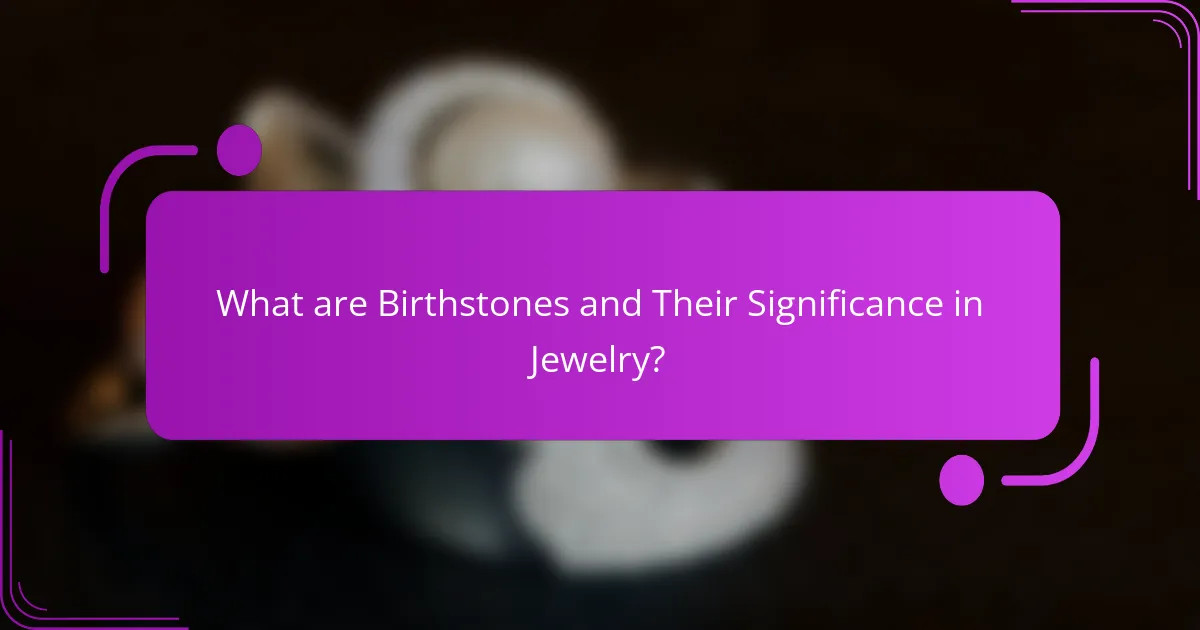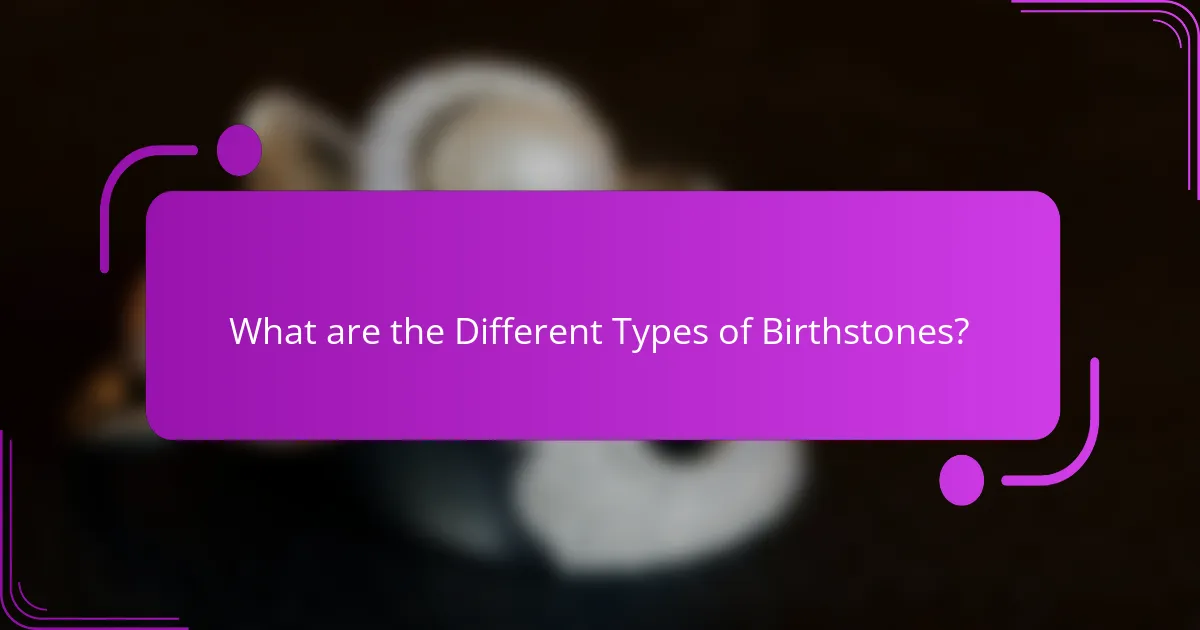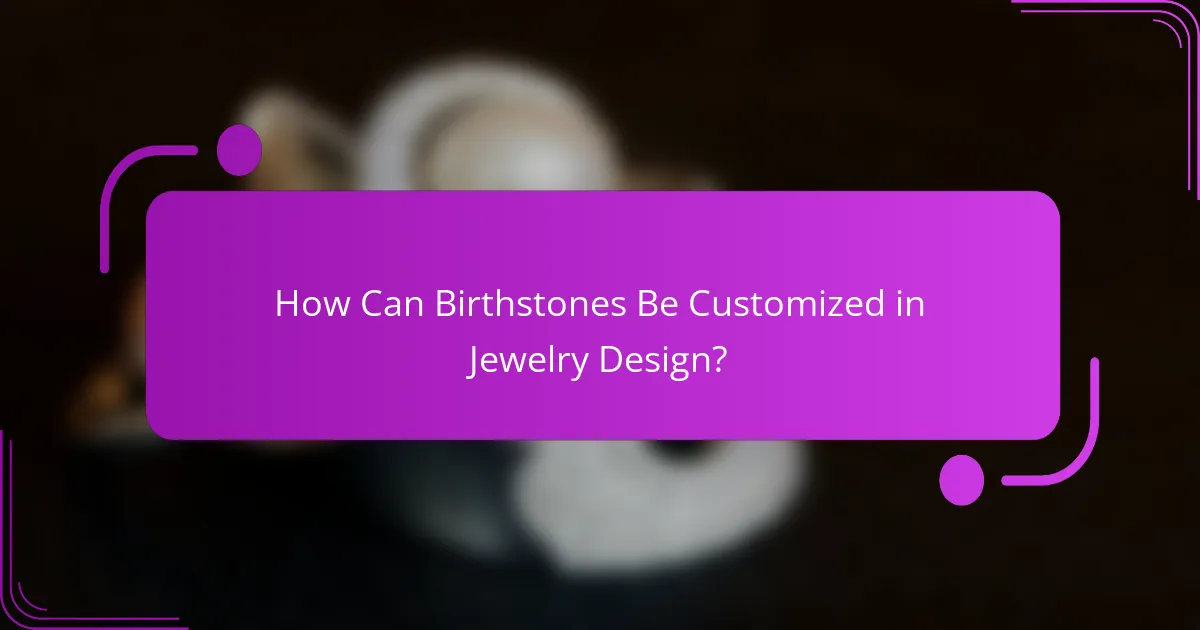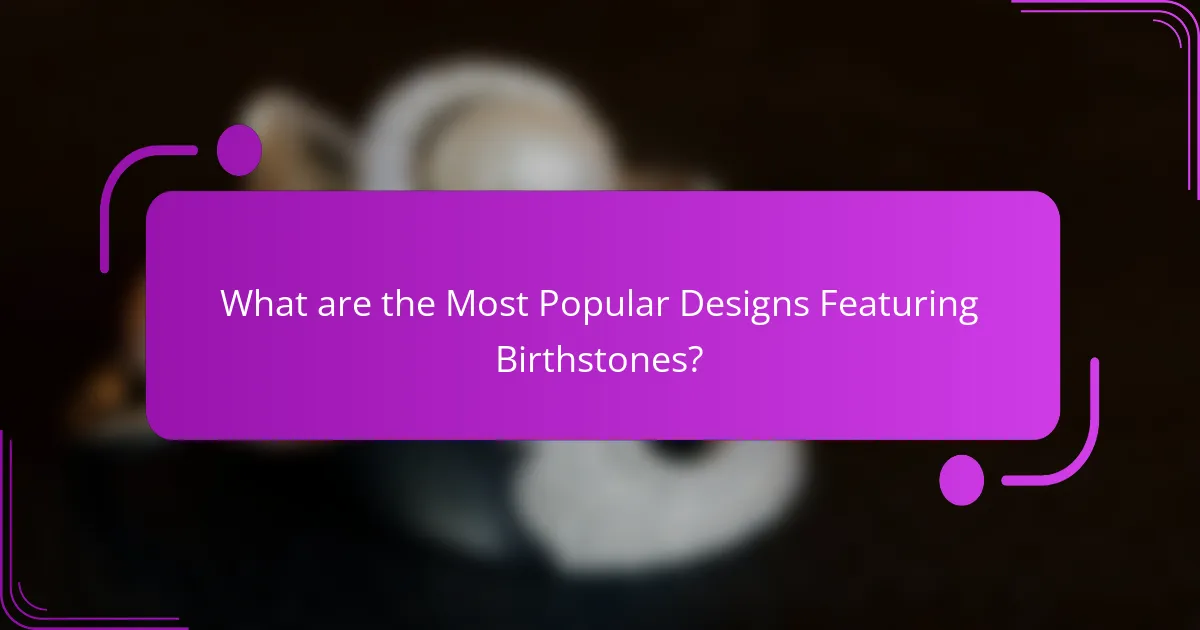Birthstones are gemstones associated with each month of the year, believed to carry unique meanings and significance for individuals born in that month. This article explores the meanings of the twelve birthstones, their historical significance, and their role in designer jewelry. It covers customization options available for birthstone jewelry, including different cuts, settings, and personalization techniques. Additionally, popular jewelry designs featuring birthstones, such as rings, necklaces, bracelets, and earrings, are highlighted for their emotional significance and appeal. The article aims to provide a comprehensive understanding of how birthstones enhance personal expression in jewelry.

What are Birthstones and Their Significance in Jewelry?
Birthstones are gemstones associated with each month of the year. They are believed to carry unique meanings and significance for individuals born in that month. Birthstones are often used in jewelry to symbolize personal attributes and to bring good fortune. For example, the garnet represents January and is thought to symbolize protection and strength. Jewelry featuring birthstones is popular for gifts and personal adornment. Many people choose to wear their birthstone as a form of self-expression. The tradition of birthstones dates back to ancient history, notably in the Bible, where they were linked to the twelve tribes of Israel. Today, birthstones are widely recognized and celebrated in various cultures around the world.
How do birthstones correlate with personal identity?
Birthstones correlate with personal identity through their historical and cultural significance. Each birthstone is associated with specific traits and characteristics. For example, garnet, the birthstone for January, symbolizes loyalty and friendship. Many believe that wearing one’s birthstone enhances personal strengths and reflects individual personality. This connection is rooted in ancient traditions, where gemstones were thought to possess unique powers. Additionally, studies indicate that individuals often feel a deeper connection to their birthstone due to its personal significance. This emotional link can influence self-perception and identity expression.
What cultural beliefs surround the use of birthstones?
Cultural beliefs surrounding birthstones often link them to specific attributes and powers. Many cultures view birthstones as symbols of luck and protection. For instance, ancient traditions suggest that wearing one’s birthstone brings good fortune. In Hindu culture, birthstones are associated with the nine planetary deities, believed to enhance health and prosperity. Similarly, in Western traditions, each month has a designated stone with unique meanings. For example, the garnet for January symbolizes protection against nightmares. These beliefs have been passed down through generations, influencing jewelry design and personal significance. Various cultures continue to celebrate birthstones during significant life events, emphasizing their enduring importance.
How do birthstones reflect individual personality traits?
Birthstones reflect individual personality traits through their historical meanings and associated attributes. Each gemstone is linked to specific qualities, such as courage, love, or creativity. For example, the garnet is associated with loyalty and passion, while the sapphire symbolizes wisdom and nobility. These associations stem from ancient traditions and beliefs about the stones’ powers. People often choose their birthstone based on these traits, reflecting their personality. Studies have shown that individuals resonate with the characteristics attributed to their birthstones. This connection enhances the personal significance of the jewelry. Thus, birthstones serve as a unique expression of one’s identity.
Why are birthstones popular in designer jewelry?
Birthstones are popular in designer jewelry due to their personal significance and emotional connections. Each birthstone is associated with a specific month and carries unique meanings. This allows individuals to express their identity or celebrate loved ones through personalized designs. Additionally, birthstones are often believed to bring good luck and protection to the wearer. The trend of customizing jewelry with birthstones has increased their appeal in the designer market. Many consumers prefer pieces that reflect their personal stories and milestones. The vibrant colors of birthstones also enhance the aesthetic value of jewelry. This combination of personal meaning and visual appeal makes birthstones a favored choice among designers and consumers alike.
What emotional connections do people have with birthstones?
People often have deep emotional connections with birthstones. These connections stem from personal significance and cultural beliefs. Birthstones are associated with specific months, representing traits and qualities linked to individuals born during those times. For example, garnet symbolizes protection and love, while sapphire represents wisdom and loyalty. Many view birthstones as talismans that offer guidance or support in life. Additionally, they serve as meaningful gifts, often representing milestones or cherished relationships. Personal stories and memories associated with these stones enhance their emotional value. Overall, birthstones evoke feelings of identity, heritage, and connection to loved ones.
How do birthstones enhance the aesthetic appeal of jewelry?
Birthstones enhance the aesthetic appeal of jewelry through their unique colors and symbolism. Each birthstone has a distinct hue that adds vibrancy to designs. For example, sapphires are known for their deep blue color, while rubies feature a striking red. These colors can complement various metal settings, such as gold or silver.
Additionally, birthstones carry personal significance, making jewelry more meaningful to the wearer. This emotional connection can elevate the overall appeal of a piece. The incorporation of birthstones allows for customization, enabling individuals to create unique designs that reflect their personality or significant life events.
Moreover, birthstones can be used in various forms of jewelry, including rings, necklaces, and bracelets, enhancing versatility in style. Their historical and cultural associations also contribute to their allure, as many people appreciate the stories behind each stone. Thus, birthstones not only add visual interest but also enrich the narrative of the jewelry they adorn.

What are the Different Types of Birthstones?
There are twelve different types of birthstones, each associated with a specific month. January’s birthstone is garnet, symbolizing protection. February features amethyst, representing peace and clarity. March’s birthstone is aquamarine, linked to tranquility. April’s diamond signifies strength and purity. May’s emerald represents rebirth and love. June’s birthstones include pearl and alexandrite, symbolizing wisdom and change. July’s ruby signifies passion and vitality. August features peridot, representing strength. September’s sapphire symbolizes wisdom and nobility. October includes opal and tourmaline, associated with creativity and emotional balance. November’s birthstone is topaz, symbolizing love and affection. December’s turquoise represents healing and protection. Each stone has unique meanings and attributes that enhance their significance in designer jewelry.
How are birthstones categorized by month?
Birthstones are categorized by month according to a traditional list established in the early 20th century. Each month is assigned a specific gemstone believed to bring good luck and protection to individuals born during that month. For example, January is associated with garnet, February with amethyst, and March with aquamarine. This categorization is commonly used in jewelry design and personalization. The practice has roots in ancient history, where gemstones were linked to zodiac signs and astrological beliefs. Birthstones are often featured in designer jewelry to enhance their significance and appeal.
What are the unique attributes of each month’s birthstone?
January’s birthstone is garnet. It symbolizes protection and is believed to enhance health. February’s birthstone is amethyst. It represents calmness and clarity of mind. March’s birthstone is aquamarine. It signifies tranquility and is associated with courage. April’s birthstone is diamond. It symbolizes strength and eternal love. May’s birthstone is emerald. It represents rebirth and fertility, often linked to love. June’s birthstone is pearl. It symbolizes purity and is associated with wisdom. July’s birthstone is ruby. It signifies passion and vitality. August’s birthstone is peridot. It represents strength and is believed to bring good fortune. September’s birthstone is sapphire. It symbolizes wisdom and loyalty. October’s birthstone is opal. It represents creativity and is associated with inspiration. November’s birthstone is topaz. It symbolizes love and affection. December’s birthstone is turquoise. It represents protection and is believed to bring good luck.
How do the meanings of birthstones vary across cultures?
The meanings of birthstones vary significantly across cultures. In Western traditions, each month is associated with a specific gemstone that symbolizes various traits. For example, garnet represents loyalty and friendship in January. In contrast, Eastern cultures often attribute different meanings to the same stones. In Hindu culture, for instance, the ruby is associated with love and passion.
Additionally, some cultures believe in the healing properties of birthstones. In ancient Egypt, turquoise was thought to offer protection and good fortune. Meanwhile, in Chinese culture, jade is revered for its connection to purity and moral integrity.
These variations highlight the cultural significance of birthstones, which can differ based on historical beliefs and societal values. Each culture’s interpretation adds depth to the understanding of these gemstones.
What are some rare birthstones and their significance?
Some rare birthstones include alexandrite, painite, and benitoite. Alexandrite is known for its color-changing properties, symbolizing adaptability and balance. Painite, one of the rarest gemstones, represents rarity and uniqueness. Benitoite is notable for its striking blue color and is associated with joy and success. These stones are not only unique in appearance but also carry significant meanings that enhance their value in designer jewelry.
What makes certain birthstones unique or rare?
Certain birthstones are unique or rare due to their geological formation, color, and availability. Unique birthstones often possess distinctive colors or patterns not found in other stones. For instance, the rare blue diamond is highly sought after for its vibrant hue and scarcity. Additionally, some birthstones, like alexandrite, change color under different lighting, making them exceptional. The rarity of a birthstone can also be attributed to its limited geographical distribution. For example, the majority of high-quality tanzanite is sourced from a single location in Tanzania. These factors contribute to the overall uniqueness and rarity of specific birthstones in the market.
How can rare birthstones be incorporated into designer jewelry?
Rare birthstones can be incorporated into designer jewelry through unique settings and custom designs. Designers can create one-of-a-kind pieces that highlight the rarity and beauty of these stones. For instance, using unconventional cuts can enhance the stone’s natural brilliance. Additionally, combining rare birthstones with precious metals adds value and elegance.
Incorporating complementary gemstones can create stunning contrasts that draw attention. Custom engravings can personalize the piece, adding sentimental value. Designers often use rare birthstones in limited edition collections to emphasize exclusivity. According to the American Gem Society, the uniqueness of rare birthstones can significantly increase the desirability of a jewelry piece.

How Can Birthstones Be Customized in Jewelry Design?
Birthstones can be customized in jewelry design through various methods. Jewelers can select specific cuts and settings to enhance the stone’s appearance. Custom engraving on the jewelry piece adds a personal touch. Different metals can be chosen to complement the birthstone’s color. Birthstones can also be combined with other gemstones for a unique design. Additionally, the size of the birthstone can be altered to fit different styles. Customization allows for meaningful personalization, reflecting the wearer’s personality or life events. This practice is supported by the growing trend of personalized jewelry in the market.
What options are available for customizing birthstone jewelry?
Customizing birthstone jewelry offers various options. Customers can choose the type of jewelry, such as rings, necklaces, or bracelets. They can select the metal type, including gold, silver, or platinum. Additionally, they may personalize the design with engravings or unique shapes. Birthstones can be set in different styles, such as solitaire or halo settings. Customers can also opt for multiple birthstones to represent family members. Some jewelers allow the choice of gemstone quality and size. Customization may include adding other gemstones or diamonds for enhanced aesthetics. These options make birthstone jewelry unique and meaningful.
How do personalization options enhance the significance of birthstone pieces?
Personalization options enhance the significance of birthstone pieces by allowing individuals to tailor these items to their unique identities. Customized engravings or settings can reflect personal milestones or relationships. This individualization transforms a generic piece into a meaningful symbol. Birthstones already carry specific meanings tied to months and zodiac signs. Personalization deepens this connection by adding a layer of personal significance. Studies show that customized jewelry is often perceived as more valuable and cherished. This emotional attachment elevates the overall importance of the birthstone piece. Ultimately, personalization makes each item a unique representation of the wearer’s story.
What role does craftsmanship play in the customization process?
Craftsmanship is essential in the customization process as it ensures high-quality, personalized designs. Skilled artisans apply techniques that enhance the uniqueness of each piece. This attention to detail allows for intricate designs that reflect individual preferences. For instance, custom birthstone jewelry requires precise setting to highlight the stone’s beauty. The craftsmanship involved also contributes to the durability and longevity of the jewelry. According to a study by the Jewelers of America, well-crafted pieces retain their value over time. Therefore, craftsmanship directly impacts both aesthetics and functionality in customized jewelry.
How can customers choose the right design for their birthstone jewelry?
Customers can choose the right design for their birthstone jewelry by considering personal style and preferences. They should evaluate whether they prefer classic, modern, or vintage styles. Next, they can assess the metal type, such as gold, silver, or rose gold, that complements their skin tone. Additionally, customers should think about the piece’s intended use, whether for daily wear or special occasions. They can also consider the size and cut of the birthstone, as these affect the overall look. Customization options, like engravings or additional gemstones, can enhance personal significance. Lastly, researching different designs and trends can provide inspiration and help customers make informed decisions.
What factors should be considered when selecting a design style?
When selecting a design style, factors such as the target audience, functionality, and aesthetic appeal must be considered. The target audience influences the design choices, ensuring relevance and connection. Functionality addresses the practical use of the design, impacting usability and effectiveness. Aesthetic appeal relates to visual elements that attract and engage viewers. Additionally, cultural context can shape design preferences, reflecting values and traditions. Material selection also plays a crucial role, as it affects durability and overall quality. Trends in the industry may guide choices, ensuring contemporary relevance. Lastly, budget constraints can limit options, necessitating creative solutions within financial limits.
How can personal stories influence design choices?
Personal stories can significantly influence design choices by providing emotional context and meaning. Designers often draw inspiration from individual narratives to create pieces that resonate with customers. For example, a birthstone may be chosen to commemorate a significant life event or relationship. This connection enhances the personal value of the jewelry. Research shows that consumers are more likely to purchase items that reflect their personal experiences. Emotional storytelling in design fosters a deeper connection between the product and the wearer. By integrating personal stories, designers can create unique pieces that stand out in the market.

What are the Most Popular Designs Featuring Birthstones?
The most popular designs featuring birthstones include rings, necklaces, bracelets, and earrings. Birthstone rings often showcase a single stone or multiple stones in various settings. Necklaces may feature pendants with birthstones, often personalized with initials. Bracelets can incorporate birthstones in charms or as part of the main design. Earrings typically display birthstones in studs or dangling styles. These designs are favored for their personalization and emotional significance. Birthstones are linked to specific months and carry unique meanings, enhancing their appeal in jewelry.
What trending styles incorporate birthstones in designer jewelry?
Current trending styles in designer jewelry incorporating birthstones include personalized birthstone rings, layered necklaces, and charm bracelets. Personalized birthstone rings often feature a single stone or multiple stones representing family members. Layered necklaces showcase birthstones in varying lengths, allowing for unique combinations. Charm bracelets frequently include birthstones among other charms, enhancing their personal significance. These styles reflect the growing trend of customization in jewelry. According to a report by the Jewelry Industry Council, personalized jewelry sales have increased by 30% in recent years, highlighting the popularity of incorporating birthstones.
How do minimalist designs feature birthstones effectively?
Minimalist designs feature birthstones effectively by emphasizing simplicity and elegance. These designs typically highlight the birthstone’s unique color and clarity. The use of clean lines and unobtrusive settings allows the stone to stand out. Minimalism reduces visual clutter, focusing attention on the birthstone itself. This approach enhances the emotional significance of the stone, as it represents personal traits and birth months. Furthermore, minimalist jewelry often employs high-quality materials, ensuring durability and timelessness. The combination of minimalism and birthstones creates a sophisticated aesthetic that appeals to modern consumers.
What traditional designs are still favored today?
Traditional designs that are still favored today include birthstone rings, pendants, and bracelets. These designs often incorporate the twelve traditional birthstones. Each stone represents a specific month and carries unique meanings. For example, garnet is associated with January and symbolizes protection. Similarly, emerald, representing May, signifies rebirth and love. These designs remain popular due to their personal significance and aesthetic appeal. Many jewelry designers continue to create pieces that highlight these traditional elements. The enduring popularity of these designs reflects a blend of heritage and modern style.
How do celebrities influence birthstone jewelry trends?
Celebrities significantly influence birthstone jewelry trends through their visibility and personal style choices. When celebrities wear birthstone jewelry, it often garners media attention and public interest. This exposure can lead to increased demand for specific styles or colors associated with their birthstones. For instance, when a popular celebrity showcases a unique birthstone piece, it can inspire fans to seek similar jewelry. Social media platforms amplify this effect, allowing trends to spread rapidly. Additionally, collaborations between celebrities and jewelry designers can create exclusive birthstone collections. These collaborations often highlight the meanings and customization options of birthstones, further driving trends. Overall, celebrity endorsements play a crucial role in shaping consumer preferences in birthstone jewelry.
What are some notable examples of celebrity birthstone jewelry?
Notable examples of celebrity birthstone jewelry include Jessica Simpson’s aquamarine engagement ring. This ring features a large aquamarine stone, symbolizing her March birth month. Another example is Miley Cyrus, who wore a stunning pink tourmaline ring. Pink tourmaline represents her October birthstone. Additionally, Kate Middleton has been seen wearing a blue sapphire ring. This sapphire is associated with her September birth month. These pieces highlight the personal significance of birthstones in celebrity jewelry choices.
How can fans replicate celebrity-inspired birthstone designs?
Fans can replicate celebrity-inspired birthstone designs by selecting similar stones and settings. Start by identifying the celebrity’s birthstone and its color. Research various jewelry styles that feature this stone. Choose a metal for the setting, such as gold or silver, based on personal preference. Utilize online retailers or local jewelers to find comparable stones. Customization options may include engraving or unique settings. Many celebrities also share their jewelry inspirations on social media, providing insight into their designs. Following these steps allows fans to create personalized pieces reflecting celebrity styles.
What practical tips should you consider when purchasing birthstone jewelry?
When purchasing birthstone jewelry, consider the quality of the stones. Look for stones that have good clarity and color. Examine the cut and setting of the jewelry. A well-cut stone enhances its brilliance. Verify the authenticity of the birthstone. Certification from gemological laboratories can confirm its genuineness. Consider the metal type used in the jewelry. Options like gold, silver, or platinum each have different properties. Pay attention to the style that suits the recipient. Personal preferences can greatly influence satisfaction. Lastly, check return policies and warranties. These can provide peace of mind in case of dissatisfaction.
The main entity of the article is birthstones, which are gemstones associated with each month of the year and believed to carry unique meanings and significance for individuals born in that month. The article explores the historical and cultural significance of birthstones in jewelry, their correlation with personal identity, and the emotional connections people have with them. It discusses the customization options available for birthstone jewelry, popular designs, and how celebrities influence trends. Additionally, it highlights the various types of birthstones, their unique attributes, and practical tips for purchasing birthstone jewelry.